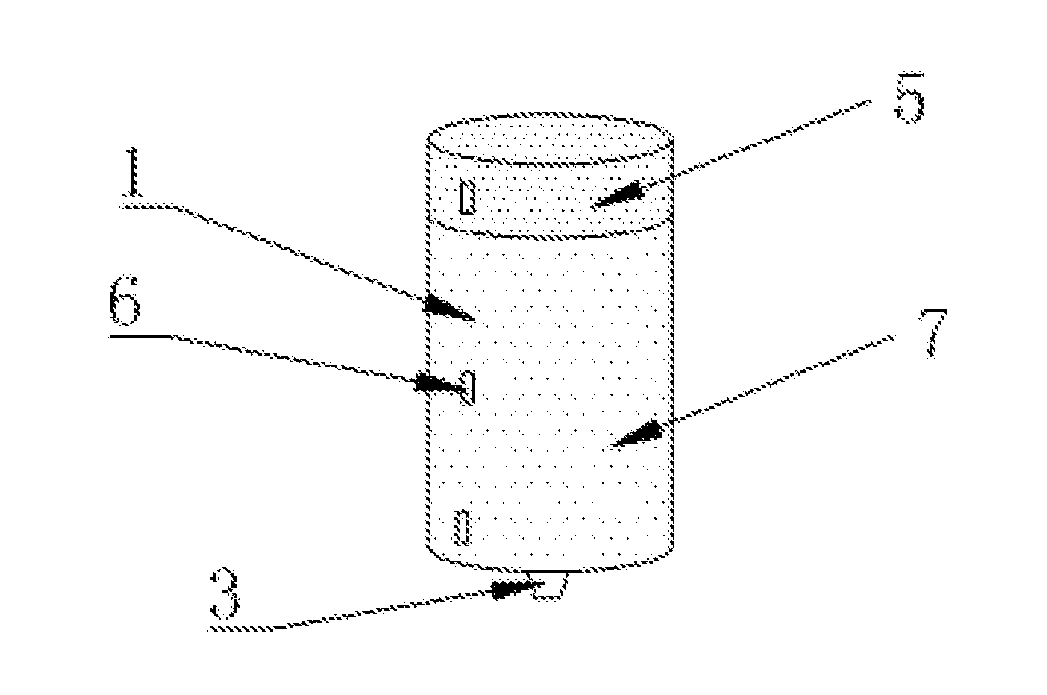Method for measuring diffusion performance of acid dye in color paste
- Summary
- Abstract
- Description
- Claims
- Application Information
AI Technical Summary
Benefits of technology
Problems solved by technology
Method used
Image
Examples
embodiment 1
[0045]6 g of a sodium alginate paste was weighted and slowly added into 94 mL of deionized water under stirring, to prepare a primary paste with a solid content of 6% for subsequent use. Then, 7.5 mL of the primary paste with a density of 1.73 g mL−1 was taken out, and 0.03 g of dissolved acid lake blue A was added, after uniform stirring a color paste with a dye concentration of 4 g L−1 was obtained for subsequent use.
[0046]Referring to FIG. 1, 1.73 g of the sodium alginate primary paste was placed into a transparent cylindrical container 1 with the specification of r=0.0068 m and 1=0.05 m, and then the primary paste was kept standing for 2 h to sufficiently remove residual bubbles therein, so that making an upper surface of the primary paste in the cylindrical container 1 is flat. 0.2 mL of the above color paste was flatly and uniformly applied on the upper surface of the primary paste in the cylindrical container 1, and then the cylindrical container 1 containing the color paste ...
embodiment 2
[0051]According to the method in the embodiment 1, the diffusion performance of acid lake blue A in a sodium alginate paste at 95° C. was measured. The diffusion time was 7.2×103 s and other experimental conditions and steps were the same as those in the embodiment 1.
[0052]Under the above conditions, the diffusion rate of acid lake blue A in the sodium alginate paste at 95° C. was measured as 5.57×10−8 mol / (m2 s).
embodiment 3
[0053]6 g of a sodium alginate paste was weighted and slowly added into 94 mL of deionized water under stirring, to prepare a blank paste with a solid content of 6%. Then, 99 g of the blank paste was taken out, and 1 g of glycerol was added, after uniform stirring, a primary paste with a glycerol concentration of 1.41×10−7 mol L−1 for subsequent use. Then, 7.5 mL of the primary paste with a density of 1.73 g mL−1 was taken out, and 0.03 g of dissolved acid lake blue A was added, after uniform stirring a color paste with a dye concentration of 4 g L−1 and the glycerol(additive) concentration of 1.41×10−7 mol L−1 for subsequent use.
[0054]According to the method in the embodiment 1, the diffusion performance of acid lake blue A in the sodium alginate paste with the glycerol concentration of 1.41×10−7 mol L−1 at 90° C. was measured. Other experimental conditions and steps were the same as those in the embodiment 1.
[0055]The diffusion rate of acid lake blue A in the sodium alginate paste...
PUM
 Login to View More
Login to View More Abstract
Description
Claims
Application Information
 Login to View More
Login to View More - R&D
- Intellectual Property
- Life Sciences
- Materials
- Tech Scout
- Unparalleled Data Quality
- Higher Quality Content
- 60% Fewer Hallucinations
Browse by: Latest US Patents, China's latest patents, Technical Efficacy Thesaurus, Application Domain, Technology Topic, Popular Technical Reports.
© 2025 PatSnap. All rights reserved.Legal|Privacy policy|Modern Slavery Act Transparency Statement|Sitemap|About US| Contact US: help@patsnap.com



